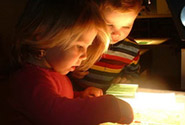Balance scale play: Random or reflective?

Two four-year-old boys are working with a balance and a collection of gourds. Tyler explains, “We're trying to get this to go this way, and this one's too heavy.”
Emerson quickly invents a solution. He adds a second gourd to the lighter end, making the combined weight heavier. Tyler is not satisfied. He indicates that this solution lies outside the rules he has created for the game saying, “No. Only one there.” Tyler removes the second gourd, causing the scale to tip with a thud. Emerson responds enthusiastically, “What?”
Tyler selects a new gourd and says, “Like, we try this one.” Notice that he briefly pauses and holds the new gourd beside the heavy gourd (00:18). What assumptions do you think Tyler may make based upon the observable similarities between the two gourds?
Tyler tries the new gourd, but the scale does not budge (00:20) and he exclaims, “What?” He says, “Hey, that don’t work,” and quickly switches it out for a gourd that differs in shape from the heavy gourd (00:24). Again, the scale does not shift and Tyler exclaims, “What?”
Emerson selects an orange gourd and says, “Now, let’s try this one.” He pushes the side of the scale down with his hand (00:35), but when released the scale tips with a thud. Emerson looks up at Tyler (00:37) and enthusiastically says, “What?” Here we see the emergence of a secondary game – the social game of mock surprise.
Emerson continues, quickly placing another gourd on the scale and exclaims, “Nothing can beat how strong this is” (00:38). His comment shows that Emerson is engaging in meta-cognitive thinking. Emerson reflects upon the efforts that he and Tyler have made in their many rounds of testing different gourds, while keeping the “strong” gourd constant, and concludes that what they are doing is not working.
Next, Emerson proposes something new. He says, “What if we take this one off?” (00:42). The game has now shifted. The children accept that the first gourd is the “strongest” (heaviest) and remove it. Alas, the gourd that Tyler puts in its place proves to also be heavy, and the game of “What?” continues.
At time code 00:55, Tyler adds a new gourd. The scale teeters and balances. Tyler exclaims, “Whoa!” The teacher (off camera) asks, “What does that tell you?” Tyler replies, “It’s balancing. And they’re both same heavy” (01:01). Tyler demonstrates his understanding of balance, or balanced weight on a balance scale (“both same heavy”), as well as his knowledge of math vocabulary (“it’s balancing”).
Seemingly invigorated by this breakthrough, Emerson swaps out a gourd for one that does not balance and says, “Hmm.” He then immediately swaps back the previous gourd that balanced and explains, “I liked it when it was like this” (01:11).
Below we offer some questions to ponder as you continue watching:
At 01:16 Emerson explores the scale itself by lifting the arms off the fulcrum and rocking the balance with his hand. What may have Emerson speculated the scale would do when he lifted it into the air? Why do you think he grasped the balance beam at the center rather than at one end? What information might he have gained by holding the scale in this manner?
Do you notice additional instances in the video when the children show meta-cognitive thinking? For example, do any of the children’s comments show they are reflecting on their own knowledge or thinking?
The children engage in a social game of feigned surprise by enthusiastically exchanging the utterance, “What?” What other words or phrases do you notice the children using to effectively collaborate? What strategies do the children use to signal turn taking, or to introduce a new idea?
Emerson is surprised when one gourd proves to be heavier than he expected (01:55). He says, “What? Was this one heavier last time?” As if to double-check, he switches the placement of the gourds on the scale (02:01). Emerson likely recalls that at time code 00:21 this same gourd was not heavier. Now, at time code 01:55 the gourd is heavier. What do you think is giving Emerson some trouble? Why may this not seem sensible to a young child?
At 02:31 Tyler says, “Let’s try two of them.” What reasoning may guide his decision to revise the “only one there” rule that he established earlier (00:10)?
What questions could the teacher ask, in revisiting this experience, or re-offering? How could the materials be prepared to support this line of investigation?
What possibilities can the teacher offer to extend the experience? David Hawkins discusses that our childhood interactions with mathematics and physics offer us the base, aesthetic, sensorial understandings upon which we build our relationships with mathematics and the sciences. This seems to be a cusp where Emerson moves from a concrete understanding and may be ready to grapple with a theoretical understanding.
Length of video: 2 minutes 57 seconds
Keywords: fours, simple machine, children-object, science, math, balance
